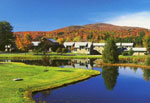Each year, the hushed stillness of a Vermont winter offers us the opportunity
for a different rhythm in our community life and hospitality, a unique invitation
to silence and listening. It is a time for dialogue, in order to deepen
the central values of our monastic path. Gradually, the winter landscape
gives way to the bursting forth of spring and the beginning of another season
of shared life.
DECEMBER 2004
Sharing our fraternal life
The celebration of Christmas was followed by our Winter Experience in
Monastic Living, during which three young men—Benjamin Rodríguez,
David Freiler, and John Flynn—participated in our community life
for seven days. Twice each year, young men bring their searching faith,
their questions, and their life-perspectives; and we are greatly enriched.
We thank each of them for their friendship.
Following the Monastic Experience, both John and David have asked to spend
a longer period of time with our community. |
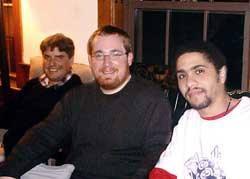
John Flynn, David Freiler, and Benjamin Rodríguez,
participants in our winter Monastic Experience. |
 |
JANUARY 2005
Witness to a life of reconciliation
The beginning of the new year was marked by the publication of A Benedictine
Legacy of Peace: The Life of Abbot Leo A. Rudloff, written by our brother
John. This loving testimony to the life and vision of our founder, brother
Leo—the culmination of several years of research and writing—has
brought his amazing story of courage and foresight to a wider public.
Persons interested in the history of our monastery, as well as in Abbot
Leo’s role in monastic renewal and in Jewish-Christian reconciliation
will find the book richly rewarding. The book’s publication was
the final fruit of the Jubilee Year of our foundation. |
We are pleased to share a few of the responses to A Benedictine Legacy
of Peace:
- Your marvelous book arrived, and I dropped everything
and started reading. […] It is such a tribute to Brother Leo, relating
his struggles, his sufferings, his achievements. […] I, for one,
was not aware of the tremendous struggles of Brother Leo to implement
the needed reforms in the reinterpretation of St. Benedict’s Rule.”
(Catherine DeVinck)
- [The book] is a wonderful tribute to Brother Leo, and
he was certainly one of the thirty-six [Just Ones] while he lived.”
(Fr. Martin Boler, OSB, prior of Mount Saviour Monastery, Pine City, New
York)
- You have created a work that speaks so eloquently of the
human, Gospel-inspired work that God brought into our lives.” (The
Rev. Richard L. Schaper)
- [Abbot Leo] stayed involved with Christian and Jewish
relations and monastic studies till the end of his life. This book is
a must for those who have Benedictine collections or collections of Catholic
biography.” (Brother Benet Exton, OSB, St. Gregory’s University,
Shawnee, Oklahoma)1
Monastic dialogue and celebration
Later in January, we traveled to Mexico, sharing the life of our Mexican
Benedictine Sisters for two weeks. This year, our sojourn in México
lindo had a dual focus.
|
Together with the Sisters, we co-hosted a gathering of representative
Benedictine women and men from monasteries in South, Central, and North
America. The gathering was a continuation of a similar dialogue held at
Weston during our 50th anniversary year. This year, we expanded our circle
and gathered at the Centro Guadalupe in Cuernavaca, Mexico. |
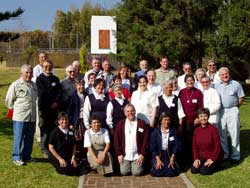
Benedictine monastics from the Americas gathered
at the Centro Guadalupe in Mexico. |
In addition
to the Weston community and members of the Mexican Sisters’ congregation,
we were joined by the following Benedictine monastics: fr. Simón
Pedro Arnold, prior of the Monasterio de la Resurrección, Chucuito,
Peru; S. Christine Vladimiroff, prioress of Mount Saint Benedict Monastery,
Erie, Pennsylvania; S. Patricia Henry, prioress of the Monasterio Pan
de Vida, in Torreón, Mexico; S. Maricarmen Bracamontes, also from
Pan de Vida Monastery; S. Lupita María Barajas, prioress of the
Benedictine Monastery of Perpetual Adoration, Tucson, Arizona; S. Bernadine
Reyes, prioress of Saint Scholastica Monastery, Boerne, Texas; fr. Thomas
Hillenbrand, abbot of Blue Cloud Abbey in South Dakota; fr. Martin Boler,
prior of Mount Saviour Monastery, Pine City, New York; and br. Marcelo
Barros, prior of the Monastery of the Annunciation, Goiás, Brazil.
In preparation for this dialogue, representing the experiences and challenges
of monastic communities throughout the Americas, we shared a paper written
by fr. Simón Pedro on the prophetic call of monastic life in today’s
world and church. In our gathering, we moved to reflection on the concrete
realities in which each community lives—politically, economically,
ecclesially. Each discussion was a call to humility. What are the questions
facing us in our rapidly changing post-modern cultures? What kind of presence-in-the-world
are we being summoned to? What must we let go of, so that true life may
blossom? How does it feel to live between the hopes of yesterday and the
unknown of tomorrow? What would it mean to accompany our people in a time
of despair and death? What do we see as the gifts that we can bring to
the peoples with whom we share our monastic life? In a profound sense,
the Cuernavaca gathering began to flesh out the three-part challenge offered
by S. Christine Vladimiroff during our Jubilee year gathering: Who are
we? What do we stand for? With whom do we stand? To touch the roots of
our monastic calling, in the company of women and men from differing cultures
and life-experiences, has been an immensely rewarding experience of the
vitality of the Benedictine vision. We all hope that the building of bridges
and the forging of links among our communities can be a witness of communion
in a world marked by disintegration.
|
The touching of roots was central to another experience which we shared together during our days of dialogue. Together we traveled to the small
indigenous village of Amaltán, approximately one hour from the
Center in Cuernavaca. Amatlán has been the home of the Nahuatl
people for millennia, and their customs and traditions as the First Peoples
continue to flourish, even in the face of persecution and domination. |
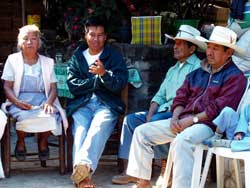
Leaders of the indigenous community of Amatlán. Ignacio Torres, center. |
The leaders of the community welcomed us, and for almost two hours, shared
their ancient history, cosmology, and present day struggles. After a festive,
traditional lunch (at which we celebrated Abbot Thomas’ birthday),
one of the community leaders, Ignacio (Nacho) Torres, lead us to a sacred
site deep into the cavernous mountains. Gathered together in a circle,
Nacho drew us into the profound mysticism of his people, inviting us to
share an indigenous ritual of prayer, invoking the Creator Spirit from
the four cardinal points. (The two poetic texts in this Bulletin are reflections
on this experience.)
The second focus of our visit with our Sisters was the celebration of
the seventy-fifth anniversary of the foundation of their congregation.
The chapel of the Sisters’ Casa Central in Mexico City was filled
to overflowing for the festive Eucharist. Elements of indigenous culture
were woven into the liturgy, culminating with sisters dancing rhythmically
down the length of the chapel, bearing clay pots of incense, and the Book
of the Gospels decorated with flowing multi-colored ribbons. The Eucharist
was followed by a festive dinner in the Sisters’ honor, complete
with traditional Mexican music and dances.
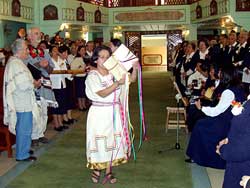
Procession with the Book of the Gospels during the 75th anniversary Eucharist at the Sisters' Casa Central, Mexico City. |
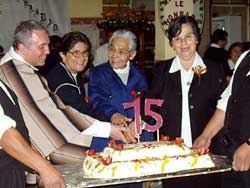
Cutting the anniversary cake. (From the right: Sister Rosa González, prioress; Sister María Durán, former prioress; Sister Fidelina Monzalvo, former prioress; and Brother Richard.) |
Following our experiences in Mexico, brother Richard participated in
the annual meeting of Benedictine Abbots and Priors, hosted by the monks
of Prince of Peace Abbey in Oceanside, California. Archbishop Michael
Fitzgerald, president of the Pontifical Commission for Inter-religious
Dialogue, was the main presenter at the meeting. Since the time of the
Second Vatican Council, monastic communities have been strongly encouraged
to become partners in the encounter of the world’s great religions.
The article “Seeing the Face of God: A Monastic Dialogue”
is a reflection on this meeting, and on the vital importance of inter-religious
dialogue.
MARCH 2005
A shared journey of faith
Once again this year, we gathered with the many friends of our community,
who join us in offering welcome and hospitality here at the monastery,
for a retreat weekend of prayer, reflection, and companionship. The generosity
of these women and men, who share deeply in the spirit of the Rule of
Benedict, makes it possible for us to open our doors to all who come.
We can never say enough how grateful we are for the gift of their friendship
in our life. |
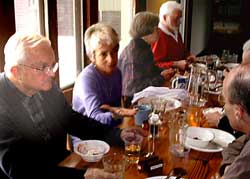
Sharing the joy of friendship
during our co-workers' retreat. |
Large numbers of persons joined us for common prayer during the days
of Holy Week, culminating in the celebration of the great Vigil of Easter.
Each year, we link this central mystery of our faith to the experiences
of passover, exodus, self-giving, and resurrection in our own time. As
we enact the Gospel of Jesus’ gift of self, we discover that it
is meant to be our story too, the journey of the entire disciple community.
APRIL—MAY 2005
The family of creation comes to life
Early spring was also marked by the birth of new lambs and rabbits, and
the arrival of piglets and baby chicks. Friends of the community, Gus
and Peggy Skamarycz and Mike Bayko, helped us to install two beehives
and generously shared their years of experience. The bees are already
making honey. The pollination of the apple orchards by the bees will lead
to magnificent blossoms, plentiful apples, and, in the autumn, apple cider
made by the brothers! All creation is interconnected. Our thanks to our
friends for helping to make this new venture in beekeeping possible.
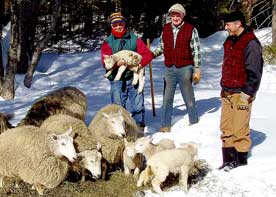
Brothers Placid, Augustine, and Daniel
rejoice in the birth of new lambs. |
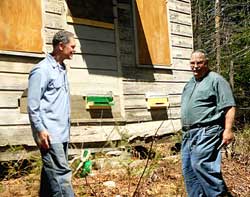
Brother Placid and Gus Skamarycz
preparing the bee house. |
‘For you I am a bishop. With you I am a Christian.’ (St.
Augustine)
The beginning of the Easter season was poignantly marked by the death
of Pope John Paul II on the Saturday of Easter Week. The Church in Latin America
has the custom of using the word Pascua (in Spanish) or Páscoa
(in Portuguese) to refer to the death of a Christian, referring to his
or her Easter. The following words from John Paul’s 2001 Easter
Sunday message are a fitting testament: “Men and women of the Third
Millennium, the Easter gift of light that scatters the darkness of fear
and sadness is meant for everyone; all are offered the gift of the peace
of the Risen Christ, who breaks the chains of violence and hatred. Rediscover
today that the world is no longer a slave to the inevitable. This world
of ours can change: peace is possible even where for too long there has
been fighting and death. Men and women, draw from Christ’s tomb,
empty now forever, the strength needed to defeat the powers of evil and
death, at the service of a better future for all.”
Bishop Kenneth Angell has served as the bishop of Burlington since 1992.
During these years, his profound humanity, deep spirituality, joy, and
pastoral love have radiated throughout the diocese. Despite clergy shortage
and other major burdens of his ministry, and especially the loss of his
brother and sister-in-law in the attacks of September 11, 2001, Bishop
Angell continued to offer the very best of himself in the service of the
local church. He continually witnessed to the inherent dignity of every
human person. For our community, he has been a faithful and caring friend.
Bishop Angell will retire as the diocesan bishop in the fall of this year,
entering into a new stage of his service to the gospel and a well-deserved
relief from the daily demands of his ministry. We will miss him as bishop.
At the same time, we wish to express to him our gratitude, affection,
and prayer.
On April 19, the entire community participated in the liturgy of ordination
of the Reverend Msgr. Salvatore Matano, a priest of the diocese of Providence,
as bishop coadjutor of the diocese of Burlington. Bishop Matano will become
diocesan bishop when Bishop Angell retires. As a Benedictine monastic
community, we join in welcoming Bishop Matano to the diocese and assure
him of our prayer and brotherly support as he begins his new ministry.
As we entered Saint Joseph’s Co-Cathedral for Bishop Matano’s
ordination, word began to spread throughout the cathedral, in whispered
tones, that Cardinal Joseph Ratzinger had been elected bishop of Rome,
taking the name Pope Benedict XVI. April 19 became a day of transition
for both the local Church of Burlington and for the entire Roman Communion.
As he undertakes his new responsibilities at a time marked by such polarization
in the church and in the world, Pope Benedict deserves the prayers of
all Christians and people of good will, that his ministry may truly be
a service of unity and reconciliation. May he be nourished by the teaching of the Second Vatican Council (in its Constitution on Divine Revelation, Dei Verbum) that the living Word of God is addressed to all God's people. In the long tradition of catholicity, our witness to the Gospel, as a Spirited communion, is symphonic- "a concert of charisms." The Word of God is addressed to all; the responsibility to listen and contribute rests on all.2
The teaching of Saint Benedict, in his Rule, on the nature of Christian leadership, can surely serve as a guide for the ministry of the bishop of Rome among the churches: that he listen with the ear of his heart, especially to the least; that he strive to be loved rather than feared; that he not crush the bruised reed; that he love the brothers and sisters; and that he prefer nothing to the love of Christ, who came to serve rather than be served. As Pope Benedict begins a ministry weighted with so much history, may he remember each day the truth once expressed by Cardinal Leon-Joseph Suenens, "that the most important day of [the pope's] life was not that of his papal election, but that of his baptism, and therein recall the dignity and wisdom of all the baptized."3 This same challenge, of living fully the radical foundation of our baptismal vocation, is one that every member of the body of Christ shares with Pope Benedict.
As a young theologian at the time of the Second Vatican Council, Joseph
Ratzinger offered this ever-challenging vision, “Christians can
never, and must never, be satisfied with saluting and loving only their
brothers [and sisters], that is, their fellow believers. They must direct
their love to all those who need them, and without asking thanks or response.
Everyone who needs their help is, by virtue of that, and independently
of his [or her] belief, a brother [or sister] of Christ—in fact,
a manifestation of the Lord himself. … A few days before his passion,
Christ described his life’s mission in these words: ‘The Son
of man came not to be served but to serve, and to give his life as a ransom
for many.’ These words express not only the basic law of Christ’s
own life, but the basic law of all Christian discipleship.”4 This
vision has lost none of its challenge or beauty. Let us all, as those
who seek to follow Jesus, support one another in living out this way of
humble service.
Near the end of April, brother Richard and brother Placid participated
in the spring meeting of the Benedictine and Cistercian communities of
New England, hosted by Saint Anselm’s Abbey.
Singing a new song
The gift of new music continues to be born in the community. The inspiration
comes from our life together, rooted in our monastic prayer and lectio,
and, very often, in our experiences among the people of Latin America.
Since early in the year the brothers have been preparing to record some
of the newest music. |
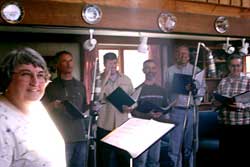
Sister Laura Bufano, CSJ, and brothers
as we record some of our new music. |
Our preparation and recording were animated by the
friendship, enthusiasm, and musical skills of Sister Laura Bufano, a member
of the Albany province of the Sisters of Saint Joseph of Carondolet. In
early May, we recorded six pieces of music, with Sister Laura directing
and John Quinn presiding at the sound mixing board. During the next months,
we will continue our preparations for another recording session. We want
to express our deep gratitude to Sister Laura and to John and Ann Quinn
for their encouragement and hospitality.
|

